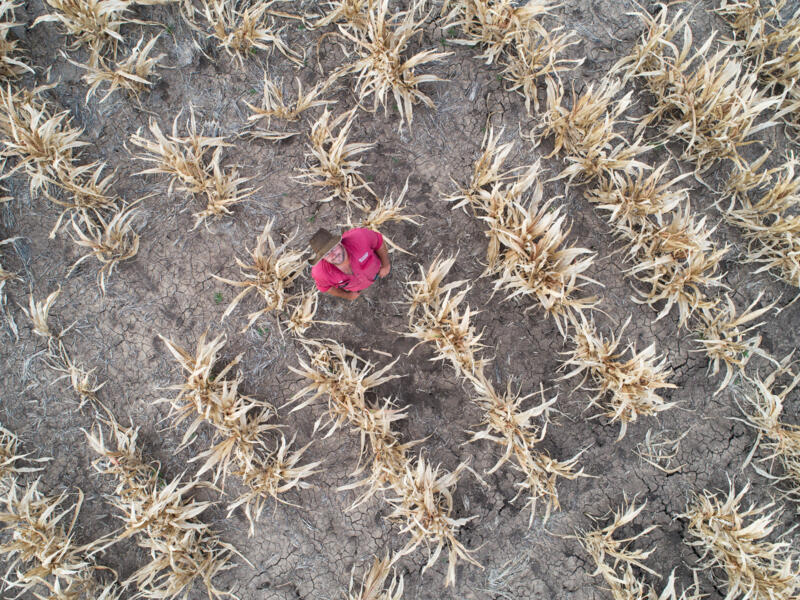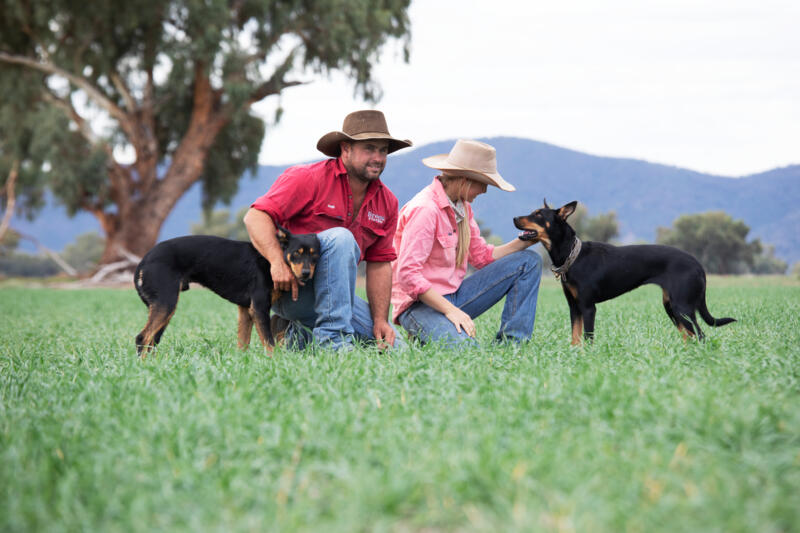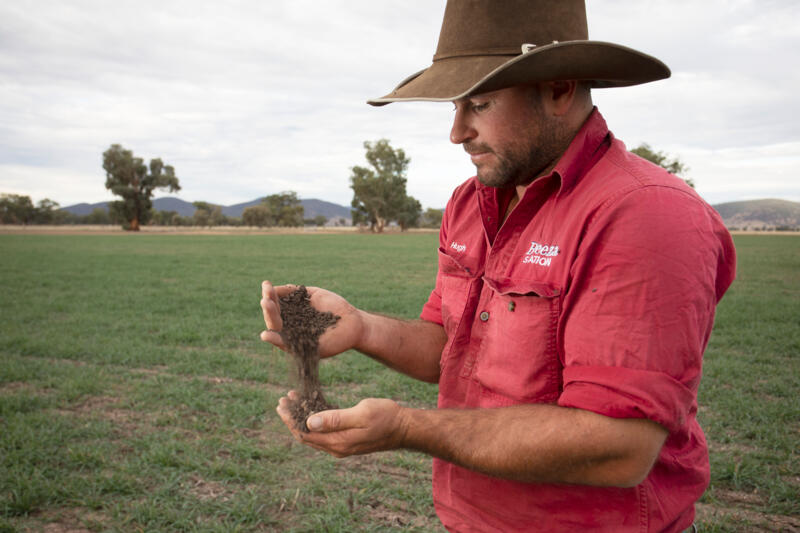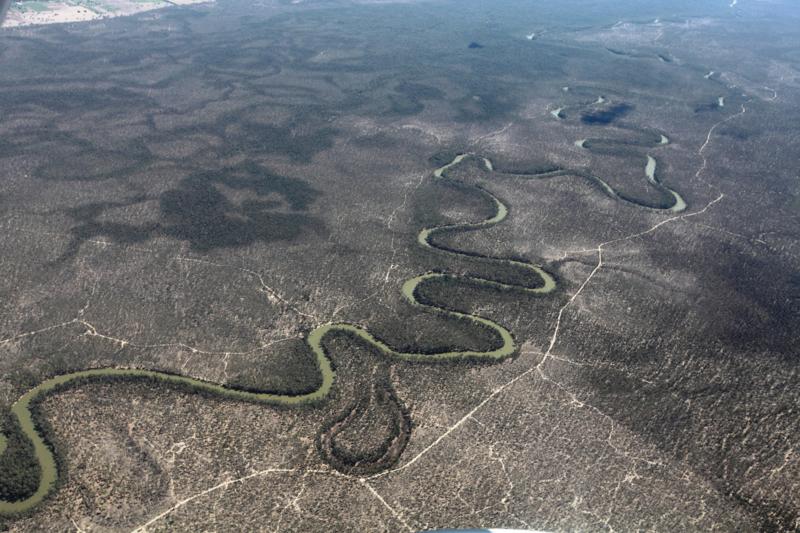THE cropping numbers are harsh. An April survey by NSW Farmers found 87% of farmers say they don’t have sufficient soil moisture to plant a winter crop. There are some tiny windows of growth, but overall the situation is bleak.
READ MORE DROUGHT SPECIAL FEATURES:
-
Horticulture growers at wits' end with drought
-
Drought survey: Farmers tell us how they are faring
Last winter, Hugh Pursehouse didn’t plant any dryland crops on his family property on the Liverpool Plains in North West NSW. There was no rain to make it worthwhile. He planted some summer crop – sorghum and corn – but 90% of it failed. Fortunately, it’s fine for his cattle to feed on, and some of the failed crop was baled and sold. He’s put in about 100 hectares of oats and winter wheat for cattle feed moving forward.
 Hugh stands among the remains of his failed sorghum crop.
Hugh stands among the remains of his failed sorghum crop.
“It’s hanging in there and we’ve got some decent growth,” he says. “But we could do with a bit more rain.”
Hugh recently got engaged to Maddy Coleman and with a wedding planned for September he has to be optimistic. He’s de-stocked most of the breeding cattle on Breeza Station – “to remove the emotional attachment”, he says – and is focusing on buying skinny trade cattle to grow them. He’s also planting more paddocks into perennial pastures instead of a crop.
 Hugh, Maddy and dogs Boss and Remy with the winter wheat crop. Last winter’s crop was the first one missed since his family bought the property in 1984.
Hugh, Maddy and dogs Boss and Remy with the winter wheat crop. Last winter’s crop was the first one missed since his family bought the property in 1984.
“I’ve got enough feed to keep going,” he says. “If the oats and winter wheat pulls off I’ll be able to finish the weaners we’ve got on hand so that’ll take the stress off.”
When it comes to cropping, Australia is almost a country of two halves, observes NSW Farmers’ Grains Committee chair Matthew Madden. The recent Western Australian wheat harvest is reported to be the second-highest on record, although they’ve produced a lot of low-protein grain which will probably end up as livestock feed.
RELATED ARTICLES ON CROP GROWERS:
-
The Riverina farmers passionate about soil conservation
-
Third generation farmers switch from sheep to cropping
-
What makes a truly innovative farmer?
-
Is lupin the new superfood?
The east coast produced higher-protein wheat, but NSW had one of the lowest productions in recent history so not enough to satisfy the millers. Usually it’s 6-7 million tonnes, says Matthew. For 2018-19, production is estimated at 1.8 million tonnes. Barley saw a similar drop, chickpeas were down about 90% while canola is down 75% on the average.
 Hugh inspecting the soil quality in a winter wheat paddock. If this one succeeds, unlike last winter’s, they will be able to finish off their weaners.
Hugh inspecting the soil quality in a winter wheat paddock. If this one succeeds, unlike last winter’s, they will be able to finish off their weaners.
According to NSW Farmers’ survey, the majority of farmers feel the Farm Innovation Fund and Regional Investment Corporation loans are of little benefit.
Instead, says Matthew: “NSW Farmers is currently investigating farm income protection products that could evolve to help mitigate some of these circumstances. Although they’ve been around a long time they’re being tweaked, and we’re looking at how they can be rolled out to overcome the question: if you have a failure, where do you get the money to plant the next crop?”
RELATED: Tax breaks needed to make insurance worthwhile
And what about the media and political commentary around cotton? “The point with cotton is that it should be framed around water use,” says Matthew.
“If that cotton wasn’t grown, the owner of the water would simply choose to grow something else with that same amount of water. It’s not cotton using the water, it’s the owners of the water choosing to use it for best return.
Deciphering the water market controversy
Not only is the lack of rain causing concern, but the controversy surrounding the water market is adding to the pressure. Steve Whan, CEO of peak national agricultural body the National Irrigators’ Council, addresses some of our farmers’ queries.
 National Irrigators’ Council chief executive officer Steve Whan. Source: Murray Pioneer, Photo by Christian Longobardi.
Are the corporate almond plantations causing problems for irrigators?
National Irrigators’ Council chief executive officer Steve Whan. Source: Murray Pioneer, Photo by Christian Longobardi.
Are the corporate almond plantations causing problems for irrigators?
“Although most almond plantations aren’t in the irrigation areas, they’re producing high returns and are in the market bidding for [water] allocations,” says Steve.
“Some of the issues irrigators have now are definitely the results of the water market rather than the [Murray-Darling] Basin Plan.” – Steve Whan
Once you’ve got a market, it’s inevitable that people will play about in it to make money.”
What are some of the other repercussions of the water market?
“There are people who had a water entitlement when they were created and then sold during the Millennium Drought because the banks told them to reduce their debt with this asset. Now these people are finding things very difficult because they’re in the temporary market trying to find temporary allocation water,” says Steve.
“Those doing it really tough are the dairy guys who don’t own entitlements, don’t make huge profits and can’t buy allocations because the price is so high.” – Steve Whan
RELATED: Dairy farmers in danger of disappearing from industry
“The water market is complicated. Some transactions take a long time to be recorded and there are different systems in different states and different products. We’d like to see it made easier to understand and track.”

The Murray river has been in the midst of a big dry. Source: Getty Images.
What else is causing confusion or anger?
“A lot of people on the NSW side of the Upper Murray have zero allocation but can see the river actually has a lot of water flowing.” – Steve Whan
“However this is on to users who’ve been able to buy it downstream, or to recharge Lake Victoria to meet the obligations to South Australia. Meanwhile they see farmers on the Victorian side enjoying much higher levels of allocation because there’s more inflow into Victorian tributaries,” says Steve.
Why is South Australia getting 100% allocation?
“It’s not actually a large amount overall. Essentially they get an annual guarantee of 800 gigalitres,” says Steve.
“What’s making NSW and Victoria angry is seeing water going out through the barrages.” – Steve Whan
“Even though that’s one of the goals of the Basin Plan, it would be nice if those advocating this in South Australia could look out of their backyard and see that every other lake is virtually empty, and be a bit more understanding of the people upstream – rather than pretending there are no problems upstream and it’s just people stealing water, which is nonsense.”
RELATED: The truth about the Murray-Darling
Some irrigators in southern NSW complain they have to compensate for the lack of water coming down from northern NSW. Is there any truth in that?
“Northern NSW is in its worst-ever state.” – Steve Whan
“If Menindee Lakes had water, some of the South Australian contribution would come from there. If there was water in the tributaries it would’ve taken a load off the Murray. There is no water in northern NSW so there is nothing to contribute. Some people say floodplain harvesting in the north has cost us water in the south, but that’s complete rubbish,” says Steve.
Footage of the current state of Menindee Lakes and the Darling River in Menindee. Source: Lach Bray, Youtube.
Extreme conditions behind drought in NSW
According to a Bureau of Meteorology report released in April, NSW has borne the brunt of the dry conditions.
- On a one-to-two-year time frame, rainfall deficiencies in the Murray-Darling Basin in 2018-19 are the third lowest on record with the problems exacerbated by record temperatures, including Australia’s hottest summer.
- Many areas of NSW including Namoi, Murrumbidgee, Castlereagh, Condamine-Culgoa, and Macquarie-Bogan have the lowest root-zone soil moisture on record.
- Averaged over the Murray-Darling Basin, total rainfall for the past two consecutive winter periods was the lowest on record, about 15% below the previous record set in 1940-41 (April to September).
- In the most drought- affected areas of NSW the majority of bores are at below-average levels.